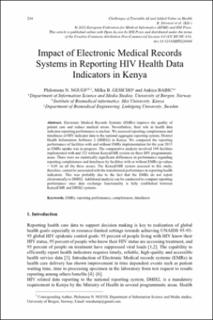Impact of Electronic Medical Records Systems in Reporting HIV Health Data Indicators in Kenya
Journal article, Peer reviewed
Published version

Åpne
Permanent lenke
https://hdl.handle.net/11250/2997837Utgivelsesdato
2022Metadata
Vis full innførselSamlinger
Originalversjon
Studies in Health Technology and Informatics. 2022, 294, 234-238. 10.3233/SHTI220444Sammendrag
Electronic Medical Records Systems (EMRs) improve the quality of patient care and reduce medical errors. Nevertheless, their role in health data indicator reporting performance is unclear. We assessed reporting completeness and timeliness of HIV indicator data to the national aggregate reporting system, District Health Information Software 2 (DHIS2) in Kenya. We compared the reporting performance of facilities with and without EMRs implementation for the year 2013 as EMRs uptake was in progress. The comparative analysis involved 104 facilities implemented with and 152 without KenyaEMR system on three HIV programmatic areas. There were no statistically significant differences in performance regarding reporting completeness and timeliness by facilities with or without EMRs (p-values > 0.05 on all the three areas). The KenyaEMR system assessed in this study, therefore, cannot be associated with the transformed performance in reporting health indicators. This was probably due to the fact that the EMRs do not report electronically to DHIS2. Additional analysis can be conducted to compare reporting performance once data exchange functionality is fully established between KenyaEMR and DHIS2 systems.
